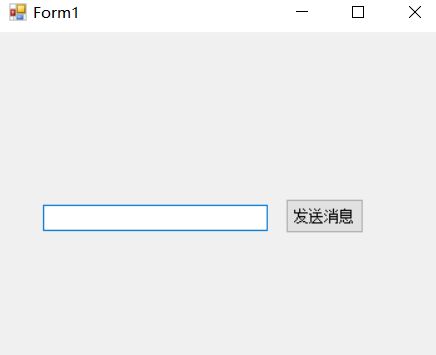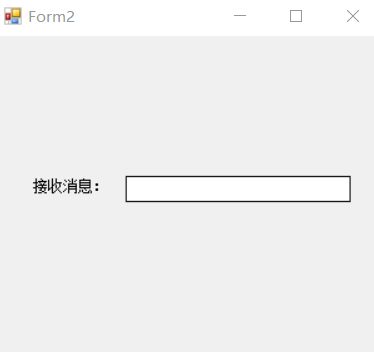C#窗体间常用的几种传值方式、以及委托与事件的详细介绍
窗体间的传值,最好使用委托方式传值,开始之前,我们先来说一下委托与事件的关系。
委托:是一个 类 。
事件:是 委托类型 的一个 特殊实例 ,只能在 类 的 内部触发执行 。
首先创建2个窗体,这里我们以form1为发送窗体,form2为接收窗体
form1窗体
form2窗体
方式一( 最简单的方式 )
form1窗体代码
using System;
using System.Collections.Generic;
using System.ComponentModel;
using System.Data;
using System.Drawing;
using System.Linq;
using System.Text;
using System.Threading.Tasks;
using System.Windows.Forms;
namespace 事件的方式实现窗体间传值
{
public partial class Form1 : Form
{
public Form1()
{
InitializeComponent();
}
public Form2 msgFrm { get; set; }
private void Form1_Load(object sender, EventArgs e)
{
Form2 f2 = new Form2();
msgFrm = f2;
f2.Show();
}
private void btnSendMsg_Click(object sender, EventArgs e)
{
//对象内部的,字段或者元素属性最好不要直接让外部直接访问
//最好是通过,设置的方法来控制一下
msgFrm.SetTxt(this.txtMsg.Text);
}
}
}
form2窗体代码
1 using System;
2 using System.Collections.Generic;
3 using System.ComponentModel;
4 using System.Data;
5 using System.Drawing;
6 using System.Linq;
7 using System.Text;
8 using System.Threading.Tasks;
9 using System.Windows.Forms;
10
11 namespace 事件的方式实现窗体间传值
12 {
13 public partial class Form2 : Form
14 {
15 public Form2()
16 {
17 InitializeComponent();
18 }
19 public void SetTxt(string txt)
20 {
21 this.txtMsg.Text = txt;
22 }
23 }
24 }
方式二( 委托方式 )
注:委托不熟悉的宝宝们,请自行查阅Func与Action,以及delegate三者区别,这里我们用系统 内置 的 委托Action
小编推荐一个学C/C++的学习裙【五八九,三四八,三八九】,无论你是大牛还是小白,是想转行还是想入行都可以来了解一起进步一起学习!
form1窗体代码
1 using System;
2 using System.Collections.Generic;
3 using System.ComponentModel;
4 using System.Data;
5 using System.Drawing;
6 using System.Linq;
7 using System.Text;
8 using System.Threading.Tasks;
9 using System.Windows.Forms;
10
11
12 namespace 事件的方式实现窗体间传值
13 {
14 public partial class Form1 : Form
15 {
16 public Form1()
17 {
18 InitializeComponent();
19 }
20 //定义委托
21 public Action afterMsgSend { get; set; }
22 private void Form1_Load(object sender, EventArgs e)
23 {
24 Form2 f2 = new Form2();
25 afterMsgSend += f2.SetTxt; //给系统内置的委托注册事件
26 f2.Show();
27 }
28
29 private void btnSendMsg_Click(object sender, EventArgs e)
30 {
31 if (afterMsgSend == null)
32 {
33 return;
34 }
35 afterMsgSend(this.txtMsg.Text);
36 }
37 }
38 }
form2窗体代码
1 using System;
2 using System.Collections.Generic;
3 using System.ComponentModel;
4 using System.Data;
5 using System.Drawing;
6 using System.Linq;
7 using System.Text;
8 using System.Threading.Tasks;
9 using System.Windows.Forms;
10
11 namespace 事件的方式实现窗体间传值
12 {
13 public partial class Form2 : Form
14 {
15 public Form2()
16 {
17 InitializeComponent();
18 }
19 public void SetTxt(string txt)
20 {
21 this.txtMsg.Text = txt;
22 }
23 }
24 }
方式三( 事件方式,更安全哟 )
TextBoxMsgChangeEventArg 类继承 EventArgs 代码
1 using System;
2 using System.Collections.Generic;
3 using System.Linq;
4 using System.Text;
5 using System.Threading.Tasks;
6
7 namespace 事件的方式实现窗体间传值
8 {
9 public class TextBoxMsgChangeEventArg:EventArgs
10 {
11 public string Text { get; set; }
12 }
13 }
form1窗体代码
1 using System;
2 using System.Collections.Generic;
3 using System.ComponentModel;
4 using System.Data;
5 using System.Drawing;
6 using System.Linq;
7 using System.Text;
8 using System.Threading.Tasks;
9 using System.Windows.Forms;
10
11
12 namespace 事件的方式实现窗体间传值
13 {
14 public partial class Form1 : Form
15 {
16 public Form1()
17 {
18 InitializeComponent();
19 }
20 public event EventHandler AfterMsgChange;
21 private void Form1_Load(object sender, EventArgs e)
22 {
23 Form2 f2 = new Form2();
24 AfterMsgChange += f2.AfterTxtChange;
25 f2.Show();
26 }
27 private void btnSendMsg_Click(object sender, EventArgs e)
28 {
29 AfterMsgChange(this, new TextBoxMsgChangeEventArg() { Text = this.txtMsg.Text });
30 }
31 }
32 }
form2窗体
1 using System;
2 using System.Collections.Generic;
3 using System.ComponentModel;
4 using System.Data;
5 using System.Drawing;
6 using System.Linq;
7 using System.Text;
8 using System.Threading.Tasks;
9 using System.Windows.Forms;
10
11 namespace 事件的方式实现窗体间传值
12 {
13 public partial class Form2 : Form
14 {
15 public Form2()
16 {
17 InitializeComponent();
18 }
19 public void AfterTxtChange(object sender,EventArgs e)
20 {
21 //拿到父窗体传来的文本,强转数据类型
22 TextBoxMsgChangeEventArg arg = e as TextBoxMsgChangeEventArg;
23 this.SetTxt(arg.Text);
24 }
25 }
26 }

